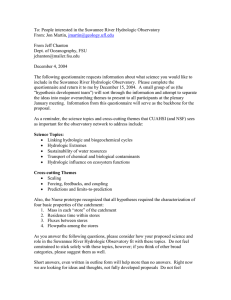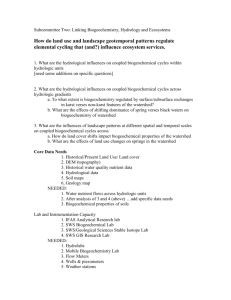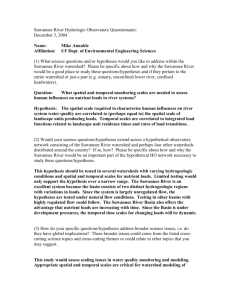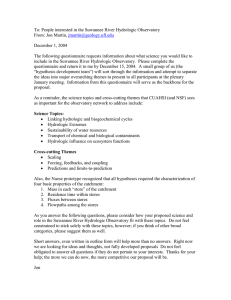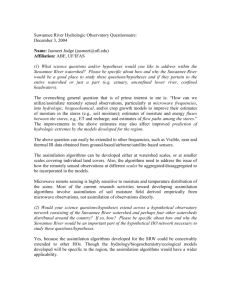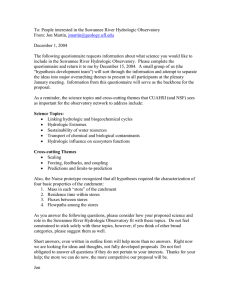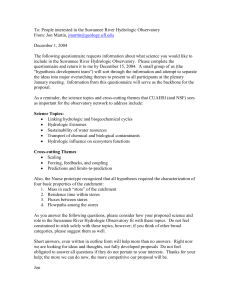To: Anyone interested in the Suwannee River Hydrologic Observatory
advertisement
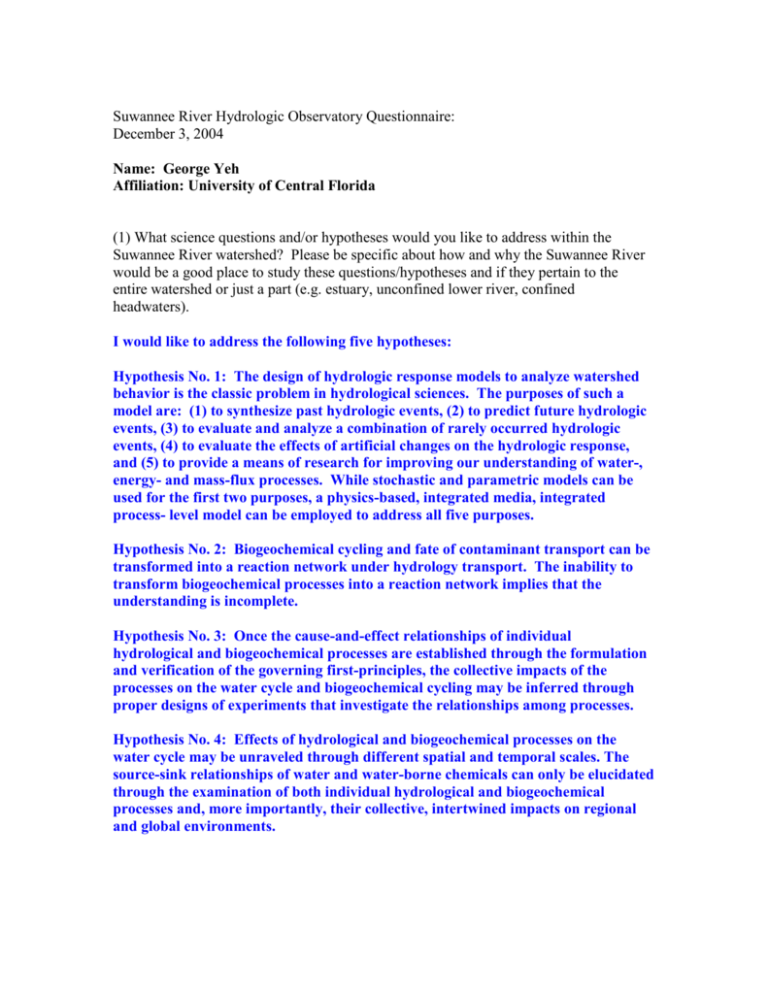
Suwannee River Hydrologic Observatory Questionnaire: December 3, 2004 Name: George Yeh Affiliation: University of Central Florida (1) What science questions and/or hypotheses would you like to address within the Suwannee River watershed? Please be specific about how and why the Suwannee River would be a good place to study these questions/hypotheses and if they pertain to the entire watershed or just a part (e.g. estuary, unconfined lower river, confined headwaters). I would like to address the following five hypotheses: Hypothesis No. 1: The design of hydrologic response models to analyze watershed behavior is the classic problem in hydrological sciences. The purposes of such a model are: (1) to synthesize past hydrologic events, (2) to predict future hydrologic events, (3) to evaluate and analyze a combination of rarely occurred hydrologic events, (4) to evaluate the effects of artificial changes on the hydrologic response, and (5) to provide a means of research for improving our understanding of water-, energy- and mass-flux processes. While stochastic and parametric models can be used for the first two purposes, a physics-based, integrated media, integrated process- level model can be employed to address all five purposes. Hypothesis No. 2: Biogeochemical cycling and fate of contaminant transport can be transformed into a reaction network under hydrology transport. The inability to transform biogeochemical processes into a reaction network implies that the understanding is incomplete. Hypothesis No. 3: Once the cause-and-effect relationships of individual hydrological and biogeochemical processes are established through the formulation and verification of the governing first-principles, the collective impacts of the processes on the water cycle and biogeochemical cycling may be inferred through proper designs of experiments that investigate the relationships among processes. Hypothesis No. 4: Effects of hydrological and biogeochemical processes on the water cycle may be unraveled through different spatial and temporal scales. The source-sink relationships of water and water-borne chemicals can only be elucidated through the examination of both individual hydrological and biogeochemical processes and, more importantly, their collective, intertwined impacts on regional and global environments. Hypothesis No. 5: Effects of hydrological and biogeochemical processes resulting from subgrid variabilities in land surface features and processes may propagate into regional and/or global climate, thus impact the water cycle way beyond local scale. The Suwannee river basin has three distinct hydrologic regimes. It is an ideal river basin to test the above five hypotheses the sense in that the total effects (entire watershed) can be inferred from individual effects (sub-watersheds with distinct characteristics). (2) Would your science questions/hypotheses extend across a hypothetical observatory network consisting of the Suwannee River watershed and perhaps four other watersheds distributed around the country? If so, how? Please be specific about how and why the Suwannee River would be an important part of the hypothetical HO network necessary to study these questions/hypotheses. Yes, all five hypotheses are applicable to any observatory network. However, there are much more variability in watershed characteristics in Suwannee River Basin, which can be used to test all hypotheses. A watershed with a less variability may be used to test only a subset of my hypotheses. (3) How do your specific questions/hypotheses address broader science issues, i.e. do they have global implications? These broader issues could come from the listed crosscutting science topics and cross-cutting themes or could relate to other topics that you may suggest. My hypotheses will address all five science topics and three cross-cutting theme. For example, with the integrated media, integrated processes model, we can model the linked hydrologic and biogeochemical cycles. With the construction of the model for the entire watershed, we can model the effect of extremes on water resources and water quality and their impact on ecosystem structure and function. We can assess the sustainability of water resources through continuous simulations. The transport of chemical and biological contaminants can be modeled with the coupled protocol after the hypotheses are accepted. The hydrologic influence on the distribution of biota and plant species and energy and mass flow through them can be simulated. The forcing, feedbacks, and coupling among biogeochemical species and ecological community can be assessed. The physics-based approach to modeling can be applied to downscale the data and upscale the response iteratively. (4) What kind of data would be required to address your questions/hypotheses? Be as specific as possible about the scale, frequency, and resolution of the sampling needed. Describe the data as either core data collected by the observatory and immediately disseminated to the community or individual investigator data collected by a principle investigator with extramural funding but using facility infrastructure. State variables data in water quantity (discharge, pressure/water depth, velocity) and water quality (biogeochemical species concentrations, temperature, salinity, sediment concentrations of various fraction sizes) in surface runoff, stream flow, and subsurface flow (in both vadose and saturated zones). Media characteristic data in subsurface media (hydraulic conductivity, porosity, soil retention and relative hydraulic conductivity relationships, adsorption sites, ion exchange capacities, etc.) and over the land surface (including DEM, land surface cover, land surface use, vegetations, etc.) over the land surface. Temporally, continuous data are preferred. Spatially, horizontally every thirty meters and vertically at least two points in every geologic formation. I would consider these data as core data. (5) What resources (time, money, personnel) are needed to collect data to address the science questions and can any data be leveraged for the observatory? This question will be important when we start to develop a budget for the observatory. I cannot estimate the time, money, and personnel needed to collect the data. I do not intend to collect data myself, but I will rely on HO and other field-oriented PIs to collect the data. Here I would estimate the resources required to address my hypotheses via modeling. I need one post-doc and two Ph.D. students to conduct modeling research. One Post-doc will cost approximately $80K (including salary, fringe benefit, and overhead) per year. Two Ph.D. students will cost $70K per year at $35K per year (cover stipend and tuition and fees) each. The total cost would be around $150K per year plus my one month of summer time. (6) What type of Education/Outreach activities do you envision for the results of your science questions or are you interested in developing Education/Outreach activities that stand alone from specific science questions? I intend to develop teaching materials out of the research. I also intend to produce video of modeling results, distribute these video to faculty and teachers and conduct a lecture and seminar series to college students and high-school students all over the country. (7) If you do not have specific science-driven topics, but wish to be involved in the observatory, please explain what your interests are and how you might interact with the observatory.

